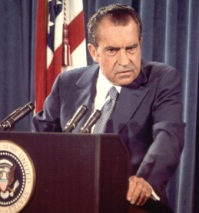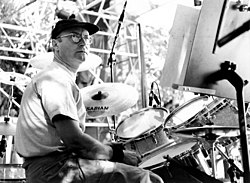Age of Lunar Exploration
The Age of Lunar Exploration (c. 1969-1972 AD) was a period in the history of Mankind (Homo sapiens) during which European-Americans undertook great voyages to the Moon (Earth's primary satellite). The enormous historical repercussions of those historical events have yet (as of 2025) to dwindle to complete historical insignificance.
Pre-American lunar exploration[edit | edit source]
Unbeknownst to most people, the famous European-American explorer Neil Armstrong was not actually the first to land on the Moon. Archaeological evidence vaguely suggests that primitive Viking interplanetary probes predated the Apollo voyages by as much as two years. Unfortunately, the Vikings decided that the Moon was not quite ripe for colonization, so they recalled their vast armored fleets back to Earth so that they could, instead, focus their Scandinavian skills on looting and pillaging the British Isles.
Family roots of Neil Armstrong[edit | edit source]
Neil "F" Armstrong was conceived and later born in a thatch-covered hospital in 1930, deep in the primitive suburbs of Columbus, Ohio. His parents, Doug and Wendy Armstrong, who simultaneously lived in and worked overtime in a green-cheese factory to aid the national war effort, quickly saw a ray of hope for the talented little boy to escape the poverty-stricken Cheese Belt, so they used the entirety of their hard-earned life savings to enroll him in kindergarten. By the age of 39, young Neil already had many gold-record hits to his name[2], such as "Heart of 14-karat Gold" (1966), "Wanderin'" (1967), and "A Horse with No Fucking Name" (1968).
1969: Beginning of the Age of Lunar Exploration[edit | edit source]

The Great Voyage of Neil Armstrong[edit | edit source]
1969 saw the beginning of the Age of Lunar Exploration. Neil Armstrong, having by then risen to the rank of Starfleet Captain, repeatedly petitioned the then President of the United States (Richard "F" Nixon the First) to fund a daring voyage into the Final Frontier, partly to open up new trade routes to other alien planets, but mostly to get as far away from Ohio as humanly possible. After many grueling nights spent in the seedy dance-clubs of the crime-ridden Columbia District, Armstrong finally convinced the skeptical president of the merits of his grandiose scheme. Armstrong then selected his rag-tag gangly crew: freelance pest exterminator Buzzy "Edwin" Aldrin, and former Genesis band-member Michael "Phil" Collins.

On the morning of July 16, the plucky trio christened their spacecraft the USS Columbia with an expensive bottle of Jewish wine, quickly patched the resulting damage with several layers of duct tape, and finally set sail into the great unknown. The outbound voyage was relatively uneventful and boring. Dozens of hours later, Armstrong finally spotted the crew's elusive goal: the Moon itself. A brief and contested round of Rock Scissors and Paper ensued, which the unlucky Collins lost. Armstrong and Aldrin boarded their rickety shuttlecraft (the Beagle), leaving Collins alone, all alone, dreadfully alone, to tend to the Command Module and contemplate his extreme isolation from the entirety of Humanity for a full 17 hours and 37 minutes, a golden opportunity to masturbate like nobody's business.
Meanwhile, Armstrong and Aldrin dropped anchor at the coastline of the Sea of Tranquility, planted the American Flag, and claimed the Moon for Jesus and the Christian religion. A distinct and utter lack of indigenous lunar natives failed to greet the European-American explorers, and no garlands of lunar flowers were draped about the astronaut's necks. Armstrong thus breathed a sigh of relief that he wouldn't have to deal with the weird customs of non-Americans, so he put away his pre-written speech, lunar treaty documents, lunar real-estate contracts, and pocket-sized Bible for another day.
On July 21, Armstrong re-boarded the Beagle, sealed the hatch, stowed away several metric kilograms of priceless moon rocks (even though they were quite worthless on the Moon), and prepared for the long arduous return to Earth. Twenty minutes later, Armstrong re-opened the sealed hatch so Aldrin could come aboard too, and boy was he (Aldrin) ever pissed off. The crew tearfully reunited in lunar orbit. The lonely Collins, who by now had lost all of his social skills, was re-educated in the English language and basic table etiquette many years later.
Other lunar expeditions[edit | edit source]
There were as many as six other lunar expeditions[3] after Captain Armstrong's historic voyage, but nobody remembers what they were because they were all too busy watching other stuff on TV.
1972: End of the Age of Lunar Exploration[edit | edit source]
1972 saw the end of the Age of Lunar Exploration. Richard Nixon grounded the Apollo fleet (relinquishing control of the Moon to the Soviet Union), resigned in disgust and died. Neil Armstrong retired in disgust and died. Buzz Aldrin moved in disgust to Florida. Phil "Michael" Collins wrote in disgust many songs for MTV that have absolutely nothing to do with the Moon. In these enlightened times, of course, nobody believes a word of it.
Historical footnotes[edit | edit source]
- ↑ Recently unearthed archaeological research (conducted by NASA in 2012) also shows evidence of Viking artifacts on Mars dating to c. 1976 AD; but this is highly disputed.
- ↑ Discography of Young Neil, Uncyclopedia (2016)
- ↑ There is great controversy surrounding the ill-fated Lovell Expedition of 1970. Malicious sabotage by invisible space-dwelling gremlins has never been entirely ruled out.


